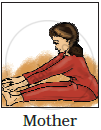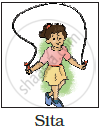Advertisements
Advertisements
प्रश्न
This is Rajiv’s family. They are a healthy family. See what each one does to remain healthy.

उत्तर
 |
Iron pumping |
 |
Yoga |
 |
Rope skipping |
 |
Walking |
 |
Drinking milk |
 |
Jogging |
APPEARS IN
संबंधित प्रश्न
Sounds are tiny vibrations that can travel through air and other materials. The loudness of a sound is measured in decibels (db).
Typical sound level in decibels:
(1) Silence 0db
(2) Rustle of leaves 10 db
(3) Breathing 10 db
(4) Radio music inside home 50-60 db
(5) Loud television 70 db
(6) Road traffic Noise 60-90 db
(7) Powerful rock music 100 db
(8) Motor cycle 105 db
(9) Heavy truck traffic 90-100 db
(10) Wind in the trees 20 db
OR
Read the following information and prepare a fact life:
Delhi, capital of India, has an area of 1,483 sq.km. Haryana and U.P are its neighbours. It has a literacy rate of 81.7%: (males 87.3 %, females 74.7%). People generally speak Hindi, Punjabi, Urdu and English. It is known for its Roshnara festival Shalimar, Qutab, mango festivals, garden Tourism and winter carnival.
How does the poem relate to our study of the Diary of Anne Frank and the events of the Holocaust?
But a caged BIRD stands on the grave of dreams
His shadow shouts on a nightmare scream
His wings are clipped and his feet are tied
So he opens his throat to sing.
Read the above lines and answer the question that follow.
What is the main conflict in this poem?
Examine the pieces of conversation in the story. How do they reflect the world view of each of the speakers?
Multiple Choice Question:
What was the result of the quarrel?
The story of Kalpana Chawla has become an inspiration for millions of young Indians. How? What message did she send from the space shuttle to students of her college?
Write what you think about the following thoughts and actions of Mathilde :
Mathilde told her friend about the lost necklace.
Tina goes to her school library to borrow a book. Complete her dialogue with the librarian by using and or or in the blanks.
| Tina | Ma’am, I want to borrow a book. |
| Librarian | Do you want a story book ______a book of poems? |
| Tina | I want a story book. |
| Librarian | Do you like stories about animals ______adventure stories? |
| Tina | I like both. |
| Librarian | Go to the second cupboard. On the first shelf, you will find animal stories ______ on the second, adventure stories. |
| Tina | Ma’am, I want Black Beauty______ Panchantantra Stories |
| Librarian | You can have either Black Beauty______Panchantantra Stories |
Read the following passage and write a summary of it. Suggest a suitable title to the summary.
|
According to some experts, a staggering 93 percent of our daily communication is non-verbal. Facial expressions are easy to decipher. One can readily detect happiness, sadness, anger. Physicians can tell a patient is doing well (or not) by looking at his/her face. Eye contact is another type of non-verbal communication, which can tell a lot about the other person. The eyes convey a range of emotions-happiness, sadness, boredom, surprise, confidence ..... even emotional interest. Staring at someone's forehead may intimidate the recipient, staring at the mouth is sometimes interpretated as a sign of emotional interest. In fact staring into someone's eyes is a sign of lying, and so is looking away. In certain cultures, lack of eye contact is taken as a sign of respect. If body language is to be defined, it is a combination of facial expression, gestures, eye contact, body movements and posture and voice. Frequent blinking is a sign of the person feeling distressed or uncomfortable. If the pupils are dilated, it often indicates interest, even emotional interest. The lips also reflect our body language, and lip biting indicates worry and/or anxiety; tightening of the lips may be an indication of disapproval. Slightly turned-up lips indicate happiness and slightly turned-down lips indicate sadness. |
As the Head of Environmental Initiatives at school, you have to deliver a speech on the occasion of World Environment Day on June 5th. Write a speech following the guidelines given below:
- Greeting or salutation and purpose – the importance of World Environment Day
- Key issues such as climate change, and pollution – the role of students in fostering a sense of environmental responsibility
- Concrete steps required towards a more sustainable and an eco-friendly lifestyle – strong call for action.
